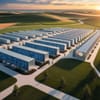The rapid growth of data centers is transforming the American landscape, with satellite images revealing the vast expansion of these facilities across the country. Over 1,240 data centers are built or planned, driven by the increasing demand for cloud computing, artificial intelligence, and digital storage. Major tech companies like Amazon, Google, and Microsoft are investing heavily in data center construction, often in areas with readily available power and water resources.
The data center boom has significant implications for the environment and local communities. These facilities require massive amounts of energy to power and cool the servers, leading to increased energy costs for local residents and businesses. Additionally, data centers use substantial amounts of water for cooling, which can strain local water resources, particularly in drought-prone areas like Arizona. The growing demand for data centers is expected to more than double climate pollution from power plants by 2035.
Some of the most notable data center locations include Northern Virginia's Data Center Alley, a hub for data centers that is home to many major tech companies. Georgia is another key location, with companies like Meta operating facilities in the state. In Arizona, Microsoft's data center in Goodyear has been approved to use up to 3 million gallons of water per day. Texas is also emerging as a major data center hub, with Meta investing $1.5 billion in a new facility in El Paso that will be powered by 100% renewable energy.
As the demand for data centers continues to grow, it's likely that we'll see even more of these facilities sprouting up across the country. While data centers bring economic benefits and jobs to local communities, it's essential to consider the environmental and social implications of these projects. By understanding the impact of data centers, we can work towards more sustainable and responsible development of these critical infrastructure.


